I could not produce our weekly Bull Bear Report this past weekend as I presented at Michael Campbell’s Moneytalks Conference in Vancouver. However, I wanted to use today’s technical update to review some of the statistical analysis we produce each week in that commentary. Such is mainly the case given last Monday’s “tariff” shock and Friday’s employment report.
It was a second volatile week of trading, which was unsurprising given the news flow. However, despite the volatility, the market continues to hold support within the current bullish trend. The market is not overbought, and the money flow remains strongly positive.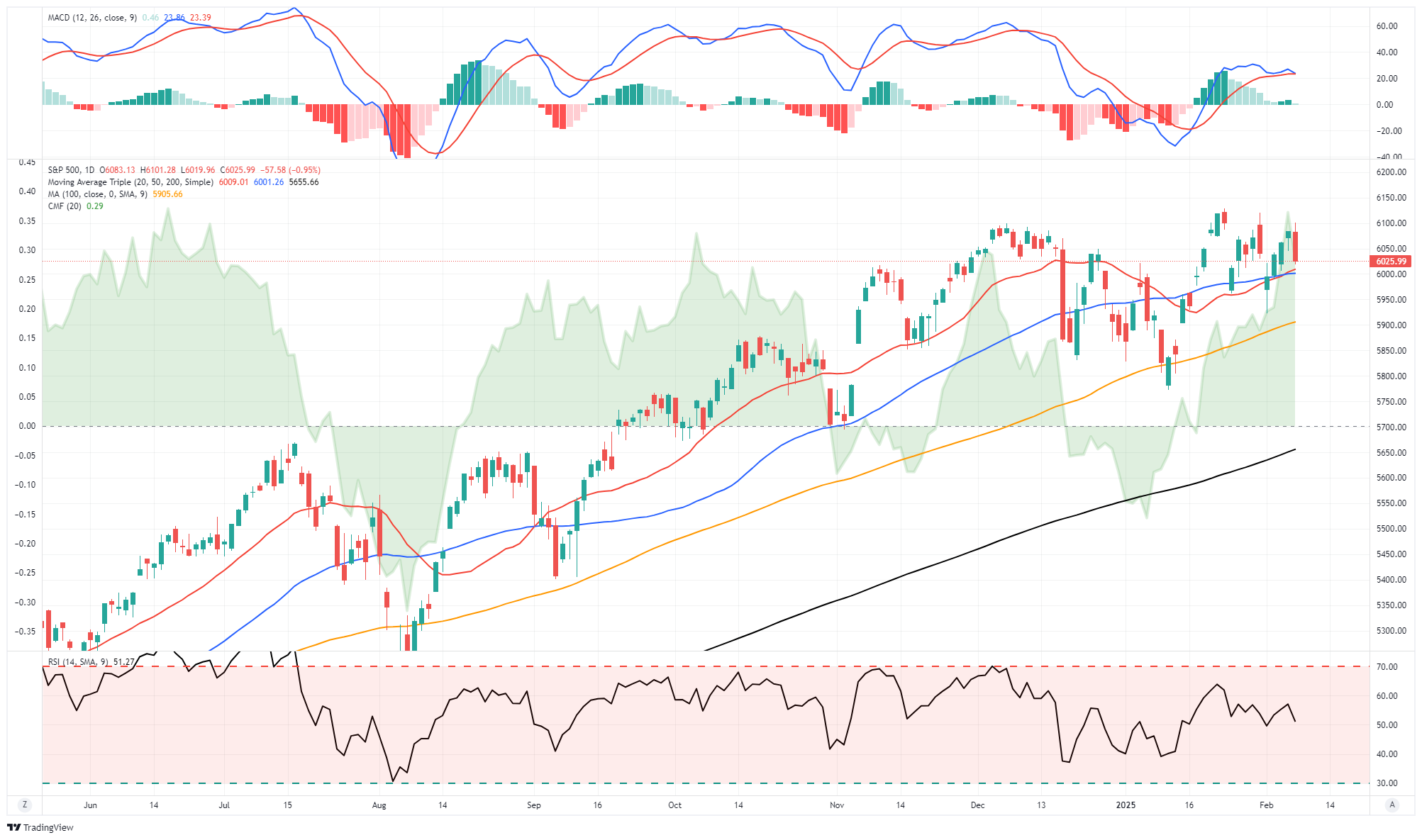
F.O.M.O. Is Alive And Well
The market defies more negative news because retail investors continue to step in and “buy the dip.” In our recent Bull Bear reports, we discussed the push by retail investors, but looking at retail sentiment is quite remarkable. Since the pandemic, retail investors have never been this bullish on the stock market. Such is amazing, given that their mailboxes are not being stuffed with government stimulus checks.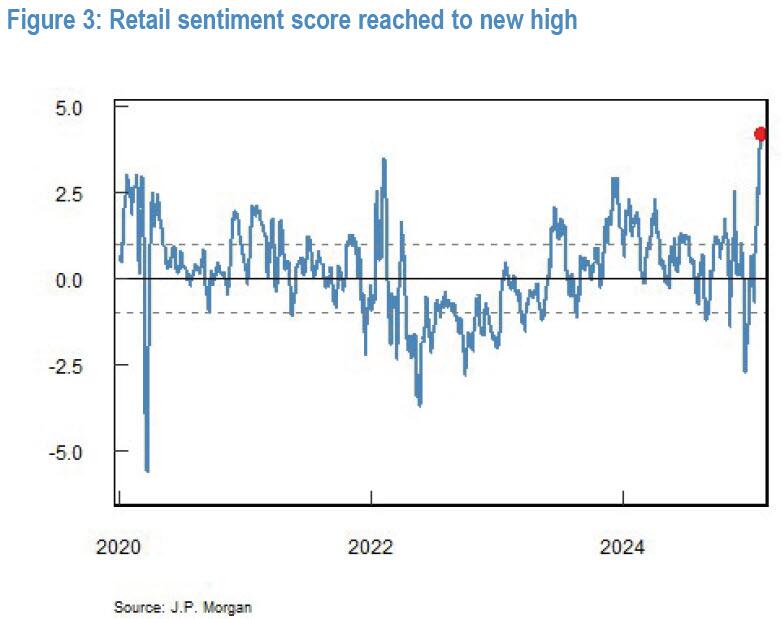
At the same time, their optimism about stock market returns is supported by putting their money where their mouth is.

The most recent AAII allocation survey of retail investors shows the same allocation to equities. Currently, their allocations to equities are at levels seen at previous market peaks and only slightly lower than the peak during the “Dot.com” mania. At the same time, their allocations to cash and bonds are near lows. While such is not indicative of a near-term market reversal, it does suggest that much of the “market gains” are already priced in by investors.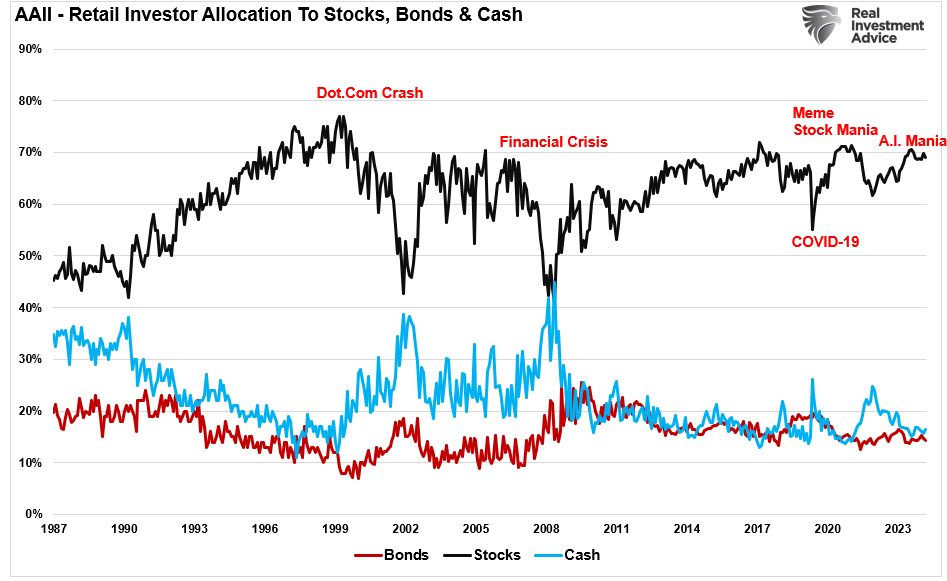
As we have often discussed in the Bull Bear Report, investor optimism or pessimism, particularly at extremes, often tend to be strong contrarian indicators. While such a statement does not mean the market is about to crash, more often than not, a period of underperformance has not been unusual.
However, weekly data is also confirming some of the same warning signs.
Weekly Data Sends A Warning
We produce several weekly tables and charts in the Bull Bear Report, which provide the framework for our risk management process. One of my favorites is the weekly Market Sector Relative Rotation analysis. The analysis comprises six charts and tables comparing the performance of major sectors and markets to the S&P 500 index. As shown, as of Friday’s close, every primary market and sector has a positive year-to-date return, with only Bonds, Emerging Markets, Small Caps, Discretionary, Staples, and Technology lagging. The most significant outperformance came from International, Communications, Healthcare, Financial, and Materials. The latter is interesting because, as we stated previously, the laggards of 2024 could well become the leaders in 2025.
The bottom left panel shows the relative performance a little differently. The market is not grossly oversold or overbought, with the S&P 500 composite average and median values about halfway through a corrective cycle. However, International, Emerging Markets, Communications, Bonds, Real Estate, and Financials were overbought after their run last week.
Profit-taking in those sectors is advisable, with a potential rotation into Discretionary, Materials, Energy, Industrials, and Small and Mid-cap stocks likely.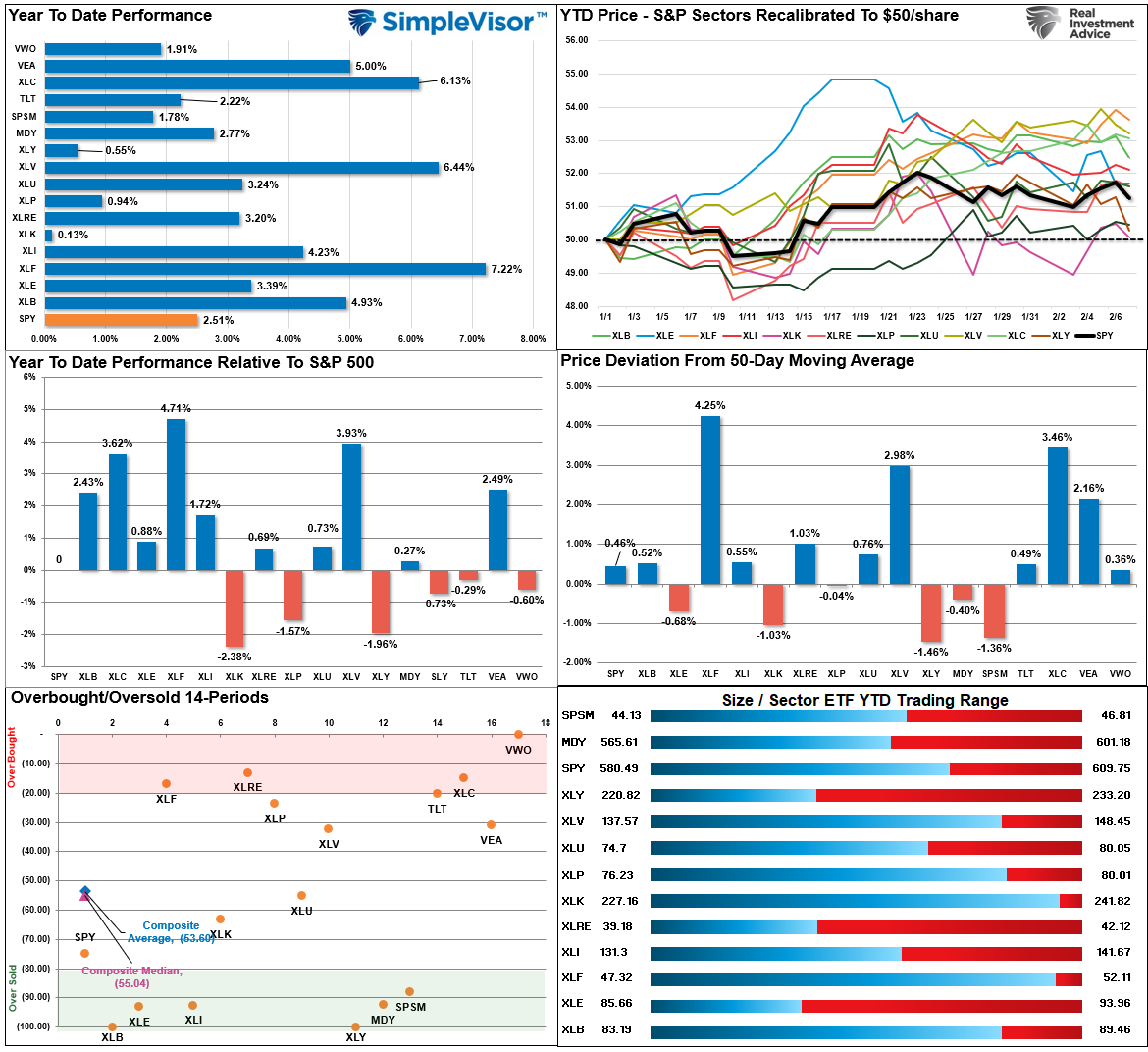
Technical Composite
To further help manage our exposure risk on our portfolios, we developed a technical composite gauge in the Bull Bear Report. This gauge comprises 10 technical indicators such as the moving average convergence and divergence (MACD), relative strength (RSI), stochastic analysis, and others using end-of-week price changes. The advantage of weekly analysis, as opposed to daily, is that it slows price movement down, which helps reduce emotionally driven decision-making in the “heat of the moment,” as we saw last Monday.
When the gauge has a reading above 80, it is generally a time to be more concerned about reducing portfolio risk. In contrast, readings below 30 are historically a good time to consider increasing risk. Looking at the chart, that seems like an obvious conclusion; however, that is a far more complicated thing to do. The reason is that when readings are above 80, it is not uncommon for the market to continue rising due to the current momentum. Conversely, when readings are below 30, the correction process will likely worsen due to momentum. However, slowing the analysis down using weekly data gives us a better perspective on the risk and the potential reward for taking that risk.
The technical gauge is currently elevated but has declined since the post-inauguration spike as the market has consolidated. Unfortunately, there is no clear signal to increase or reduce risk. However, if the markets continue to hold support and the technical conditions continue to improve, this could provide a decent opportunity to increase exposure over the next few weeks.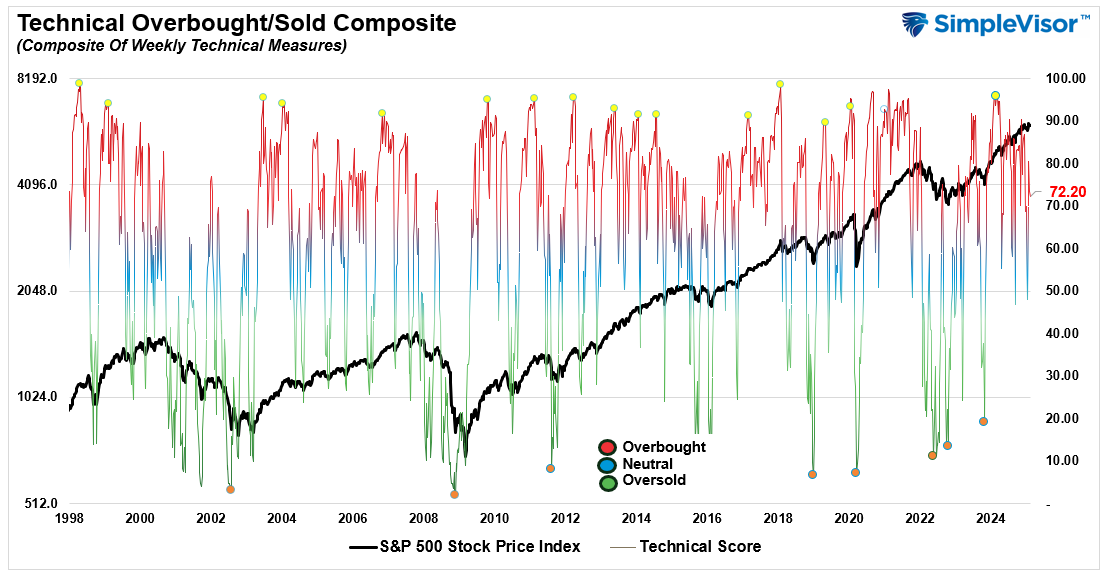
Sentiment
As shown in the retail analysis above, the weekly “Fear/Greed” gauge in the Bull Bear Report also comprises several investor sentiment and allocation indicators. While retail investor sentiment is very high, professional investors are also bullish but a little less so. This gauge differs from the CNN Fear Greed index, which uses the S&P 500 as one of its components. This gauge aims to determine how investors “feel” and how they are “allocating” their money in the market. Retail investors were slightly less bullish this past week, but professional investors got more bullish in their allocations, keeping the index at “greed” levels. Like the weekly technical gauge above, this level does not indicate an immediate market downturn but does suggest the recent consolidation process will continue capping gains in the short term.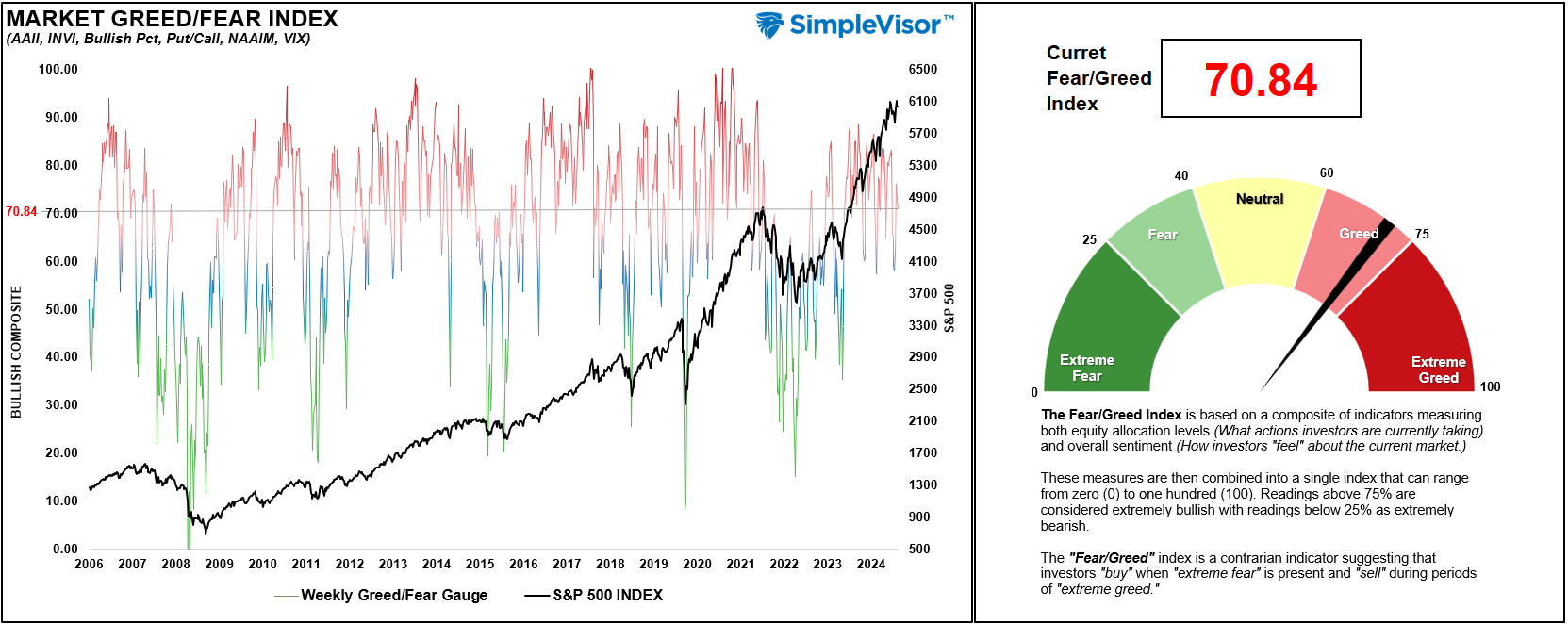
However, there is one piece of weekly technical analysis that we are watching exceptionally closely.
Risk Management Is Key
As noted, we regularly publish our analysis and statistics in the weekly Bull Bear Report. A chart we do not regularly publish is the one we primarily use to control our portfolio exposures. The Weekly Risk Management Analysis is key to how much exposure we maintain to the equity market at any given time. The chart below matches an intermediate and longer-term weekly MACD signal to the markets. When both signals are on “buy signals,” such has coincided with a trending bull market advance. When both signals confirm a “sell,” as in early 2022, the market has gone through correctional phases.
Currently, while early, both the intermediate and longer-term MACD “sell” signals are registered. There are several crucial points to note:
- The market is trading at the top of its long-term trend channel from the 2009 lows. While it previously traded above that channel in 2021 due to artificial stimulus, the current advance may be near its current cycle peak.
- These are weekly signals and, therefore, very slow to move. Signals can whip back and forth for a month or more before becoming confirmed by a breakdown in the market.
- As noted, the market’s price action must confirm the “buy” and “sell” signals. If the market enters a deeper corrective phase, a break of the 34-week moving average will confirm the end of the bullish advance that started in 2022.
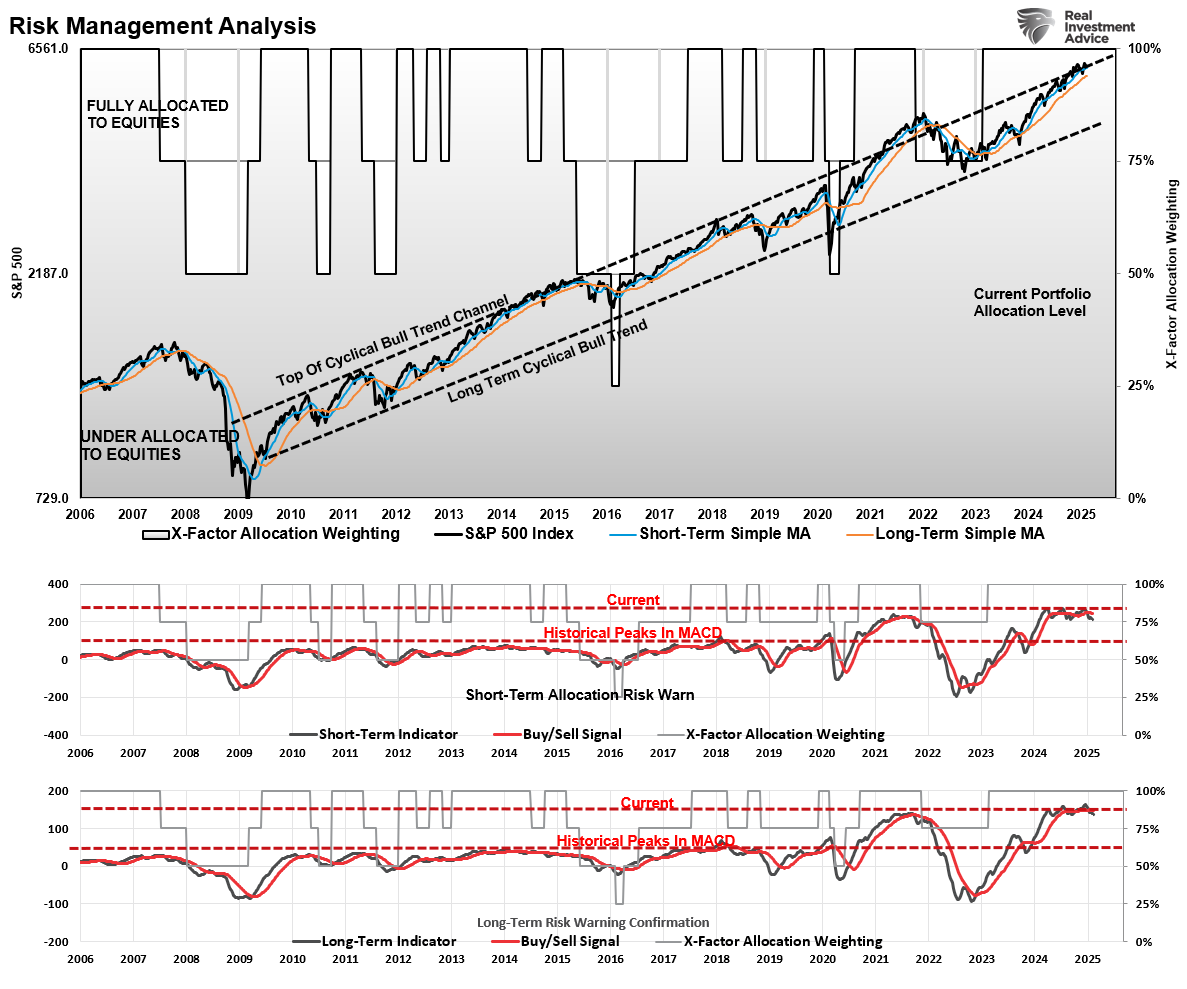
Notably, while bullish and bearish signals exist, the market can remain in flux for quite some time. For example, the market continues to trade bullishly, which suggests continuing the current trend. However, triggering weekly sell signals from high levels suggests caution is warranted. Therefore, while some technical indicators provide conflicting signals, investors must manage near-term risk while waiting for markets to confirm their next direction.
5-Actions Investors Can Take Today to Minimize Risk
Given the mixed technical outlook for the S&P 500, investors should focus on managing risk while positioning themselves for potential market swings. Here are five actions to consider:
1. Trim Winning Positions Back to Their Original Portfolio Weightings
This strategy involves reducing your exposure to positions that have grown beyond their initial allocation due to price appreciation. When a particular asset or stock performs well, its weight in the portfolio increases, potentially leading to overexposure and imbalance. Trimming these positions back to their original weight helps lock in profits while maintaining your intended risk profile. It’s a way to ensure that no single asset dominates the portfolio, which could lead to increased risk if that asset faces a downturn.
2. Sell Those Positions That Aren’t Working
Selling underperforming assets is essential for managing risk and avoiding unnecessary losses. Suppose a stock or asset consistently underperforms relative to its peers or the market. In that case, it may be a sign that the investment thesis has failed or external factors negatively affect the position. Selling these positions frees up capital investors can reallocate to better-performing or more stable assets. It’s a proactive step to cut losses and prevent further erosion of your portfolio value.
3. Move Trailing Stop Losses Up to New Levels
A trailing stop loss is a risk management tool that automatically adjusts as a stock price rises, locking in profits and protecting against downside risk. Moving these stop-loss levels up as the price of an asset increases ensures that if the market reverses, you can capture gains without manually monitoring and selling the position. This strategy helps protect profits while allowing for further upside potential. It’s advantageous in volatile markets where prices can fluctuate significantly.
4. Review Your Portfolio Allocation Relative to Your Risk Tolerance
You should always align your investment portfolio with your risk tolerance, which may change over time due to market conditions or personal factors such as age, income, or financial goals. Reviewing your portfolio allocation means assessing how much your portfolio is invested in different asset classes (e.g., stocks, bonds, cash) and ensuring the risk level matches your current comfort level. For instance, if your portfolio has become more aggressive (higher exposure to stocks or growth assets), you may need to rebalance to reflect a more conservative risk profile, particularly as market conditions change.
5. Raise Cash Levels And Add Treasury Bonds to Reduce Portfolio Volatility
Increasing your cash allocation is a simple but effective way to reduce portfolio volatility. In times of uncertainty or market downturns, holding more cash can help minimize losses and provide liquidity for future opportunities. Cash is a low-risk asset that doesn’t fluctuate with the market, so increasing your cash position can help stabilize the overall portfolio and provide peace of mind during volatile periods.
Furthermore, investors consider Treasury bonds safer investments than stocks, providing stability and predictable income through interest payments. Adding bonds to a portfolio can help reduce volatility, particularly during economic uncertainty or stock market corrections. Bonds tend to have an inverse relationship with stocks, meaning they can perform well when equities struggle, particularly during Fed rate-cutting cycles.
Conclusion
The S&P 500’s technical landscape presents both opportunities and challenges. Bullish indicators such as moving average support levels and positive money flows suggest a “buy the dip” opportunity could be on the horizon. However, bearish patterns and weaker technical signals suggest caution.
We don’t know what will happen next, nor does anyone else. Therefore, we suggest a regular diet of risk management and portfolio rebalancing to navigate periods of elevated uncertainty.
Could I be wrong? Absolutely.
But what is worse:
- Missing out temporarily on some additional short-term gains or
- Spending time getting back to even, which is not the same as making money.
“Opportunities are made up far easier than lost capital.” – Todd Harrison
Trade accordingly.
